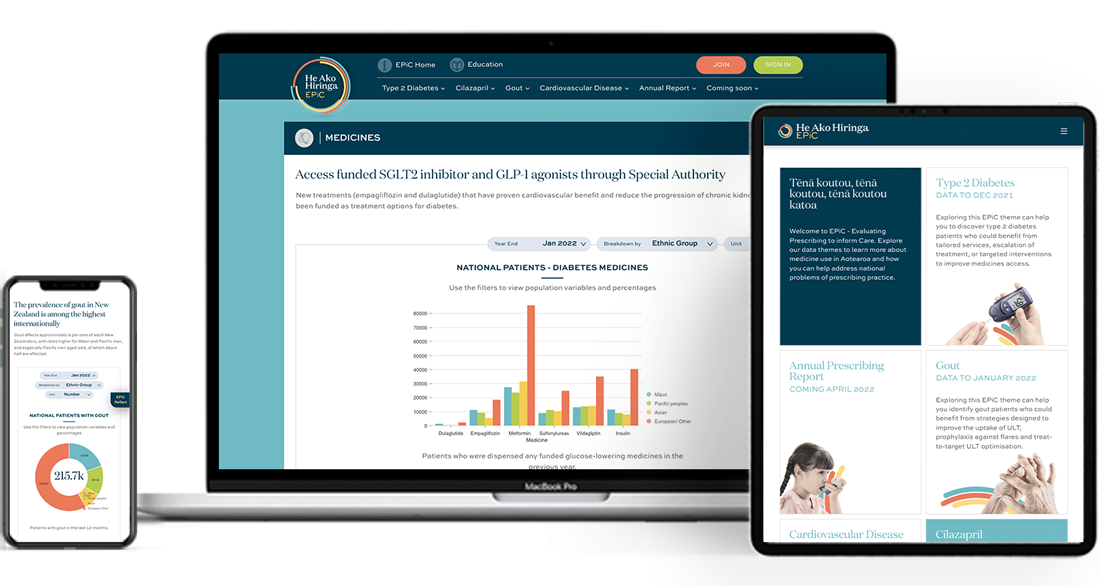Matui is a research and data analytics company seeking to turn statistics into change. By arming New Zealand's primary health sector with actionable data intelligence, Matui supports Pharmac’s strategic priorities of using data and analytics to enable equitable access and use of pharmaceuticals.
Matui’s concept behind the 'EPiC' platform (Evaluating Prescribing to inform Care) was to create an analytics tool that could be used to explore individual prescribing behaviours and how they relate to national problems of prescribing practice. Using aggregated data from the Ministry of Health’s National Collections, Matui has created an interactive, personalised, report-style dashboard – the first of its kind in New Zealand.
Prescribers can compare their own prescribing to prescribing for all patients within their practice and nationally using age, gender, ethnicity, and socioeconomic deprivation quintile filters. These data insights can help them reflect on their prescribing and/or inform targeted interventions or quality improvement activities.
As experts in digital product creation, Communica was able to provide the necessary skills for:
- Design and user experience
- Graphing and data visualisation
- Onboarding and access management
- Big data consumption
- Database architecture
- Privacy and security practices
Back End Solution
Communica's toughest challenges on this build were all related to the impact big data brings. Therefore, the team needed to choose technologies which would scale with load, respond quickly to user interaction and remain highly extensible. The backend technology selected for this project included:
- MongoDB (Database)
- GraphQL (API query language)
- Amazon (Serverless Hosting)
In terms of database, although MongoDB could be considered "the road less travelled by", it was perfect for this project. As a "NoSQL" flavoured database, MongoDB wasn't restricted by any schema, scaled horizontally, and offered a faster read speed than that of any SQL based solution.
This powerful feature set gave Matui the flexibility to create data stories which were uniquely tailored to each 'problem of practice' theme. Graph widgets could instantly adapt to the data set uploaded, and in the future, topical data (such as COVID related impact) can be introduced periodically without any need for additional coding.
Doubling down on agility, Communica took a serverless approach to hosting. This lowered cost, removed the need for server side maintenance, but moreover allows the platform to scale up and down at will. An important consideration given the unpredictable peaks and troughs of user interaction.
Front End Solution
For the application's front end, Communica's strategy hinged on developing a library of graphs and sectional content which could be added to each page as required. Moving forward, this architectural decision will allow Matui to hit the ground running and expedite new topical content as it arises.
The technology chosen for the front end included:
- React (JavaScript library)
- Nivo charts (Graphing library)
- Storybook (Component repository)
For its powerful graphing features without the bespoke price tag, Communica's front end team chose open source chart library 'Nivo'. Graphs selected by Matui's data scientists were then wrapped inside widgets and integrated with a custom GraphQL API - pulling the relevant data out of MongoDB.
To ensure the custom and library elements were infused with the same visual consistency, Communica opted for Atomic Design methodology together with a Storybook component library. This library, shared between the two teams allowed for rapid development as the components could be prototyped and signed off from a visual and interactive perspective, in isolation from the project interface or a live API connection.
In terms of engagement, encouraging the user to explore, flip between filters or compare trends meant the interface had to be quick on its feet. By picking Javascript based libraries like React and Nivo, Communica could remove the need for page reloads between each graph query, breaking down the barrier between exploration and load time.
While an intensive build, EPiC was also equally rewarding. Combining the latest technologies, big data, and the potential to help create equitable access to funded medicine across New Zealand was a once in a lifetime opportunity and not to be missed!
If you have a project which requires equal parts; creativity, business acumen and development excellence, please get in touch today.

